The Story of the Totem Pole
by Megan Dethier and Joshua L. Reid (Snohomish)

For those who haven’t been to FHL in the last 2 years, an amazing item now graces the entryway of the Fernald Building: a gorgeous totem pole. Dr. Eugene Nester, UW Emeritus Professor of Microbiology and long-term member of the Whiteley Center Administrative Committee, purchased the pole in Seattle from Darrel Norman, a Blackfeet artist. Mr. Norman told Dr. Nester that the pole had been owned by David Tobias, owner of the Seattle Tent and Awning Company, who built a resort near Mt. Rainier where the pole was displayed. It then went to Mr. Tobias’ daughter, who owned it for many years. She wanted to will it to the Burke Museum at UW, but the museum already had similar examples. Consequently Darrel Norman got it, and eventually sold it to Dr. Nester. Eugene Nester has spent many productive hours at the Whiteley Center at FHL and knew that the totem pole would be a beautiful and appreciated gift to our facility. He generously donated it in Fall 2022.
After we posted a picture of this remarkable gift on social media, we got a call from Rick Williams, who is himself a carver and recognized the pole as the work of his grand-uncle. To our amazement and delight, he asked if he could come restore it! We were aware that the pole looked old, but would only have considered restoration if such a qualified person had been willing to take on this delicate work. Rick and his son, EagleSon, spent two weekends at FHL in Spring 2023 restoring the pole; this happened while Josh Reid was teaching The Indigenous History & Environment of the Salish Sea course here at FHL, so the timing was perfect for creating wonderful connections. And the before-and-after photos (Figure 1) illustrate what a magnificent difference the restoration made! To add to the bonus of having Rick and EagleSon at FHL, they told us the story of the figures on the pole, which many had been wondering about.
The following information comes from an interview done in Spring 2023 between Rick Williams, EagleSon Williams, FHL instructor Josh Reid, and student Kamālieoke’ehukai Jellings:
The totem pole was created in 1927 by Wilson A. Williams, a noted Nuu-chah-nulth (formerly referred to as Nootka) carver who lived on the west coast of Vancouver Island. Wilson was the oldest of 4 brothers who were all carvers, and many of the Williams family are still carvers today. Wilson carved poles for Ye Olde Curiosity Shop on the waterfront in Seattle. This pole was carved from an old growth red cedar from the mountains of Vancouver Island; estimates are that it might have been a nine-hundred-year-old tree. The tools Wilson used were little bent scoop chisels that he made himself, and a small mallet. Wilson’s brother also taught him how to use a black rock and a “chuhyuk” – a hand-adze – but he preferred his special chisels, and each brother had his own style.
Rick Williams, who is a member of the Ditidaht First Nation on Vancouver Island, is a grand-nephew of Wilson and a seventh-generation wood carver; his son EagleSon is eighth generation. It was very important to Rick to be able to restore this pole, carved by his grand-uncle, since previously he had only heard stories about what Uncle Wilson did. He decided to restore it both to establish this connection with his ancestor and because he saw it as a way of sharing his gift and making it a community effort. He said he felt energy when touching his uncle’s work – it flowed through him and gave him strength to keep carving. “When you’re carving there’s nothing. There’s no sound…you know, depending on your state of mind, what you’re looking at… I hear drums and language when I’m carving.”
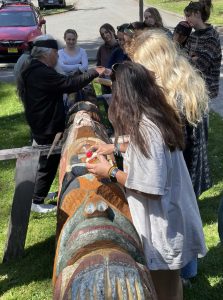
He was also inspired by the FHL students who wanted to be part of the process of restoration. “You know they’re genuinely interested in what you’re doing, and you can tell as a carver that they want to try it. So, we allow it because then they’re part of something. That means the community had Grandpa’s thoughts still working, and that the people wanted to be part of that whole, because no one’s ever done anything like that. We were taught to share with people a gift of what we can do together. I heard, in my travels, ‘we’re sacred carvers.’ I know that, but in order to make sacred work a goal, keep your eye and heart open to share the gift.”
The restoration started with Rick putting his hand on the pole and saying a prayer in Ditidaht (his people’s language), and in his heart saying to his Uncle Wilson, “I wanna do what I can, Uncle.” He said “It’s always a must – if you’re going to repair someone’s work, say a prayer first before you even get to work on it. This is giving respect to that person.” The next step was looking for cedar chips to help fill missing pieces, especially in the bear’s ear and mouth; if he just poured in glue, it wouldn’t close. So, he patched it up, re-sanded it, and then repainted it with the help of FHL students and staff. He was delighted to draw on the students’ energy, and “to hear people say ‘Wow!! You brought it back to life!’ And I was like: ‘Yes! That’s what I wanted to hear!’”
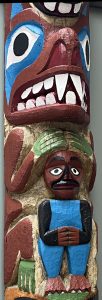
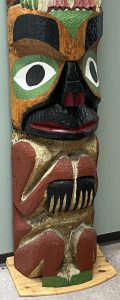
Here is what Rick told us about this pole’s story: Poles are generally carved to be in front of someone’s house. At the bottom of the pole is the elder: the person who guides, helps, and teaches the family (Figure 3). Above the elder is a mother bear holding a human (Figure 4). She’s a loving mother, protector, and guardian. Above the bear is a mother orca whale (Figure 5). She is included because the local whale hunters wanted to honor her, to keep her spirit alive, so someone created this story. The whale was taken and used for medicine, oil, and food. On the top of the totem pole is a bird (Figure 6). “People think it’s an owl, but it isn’t. It’s actually a baby eagle or teenage eagle, going out into young adulthood, and asking the elder to teach it: I wanna do this on my journey.” The eagle has a “copper” (a shield) on the front of its chest; the copper is a sign of wealth and prestige, and “helps to repel negative, bad vibes – evil, if you will.” On the shoulders of the figure’s wings are serpents (note the scales on the side in Figure 6), representing the serpent of life. “So, this person is saying they want to be a healer.”
The carving and its artist are not traditionally/culturally from the San Juan Islands. However, the islands have long been an important meeting point for Indigenous peoples from all over the Northwest Coast. The totem pole is not representing or claiming territory for any tribe, culture, or people; rather, it is on display for its remarkable artistry and craftmanship. However, by providing a home for the pole and supporting Rick’s work to restore it, FHL is demonstrating just one of several ways that we remain accountable to local Native nations and Indigenous communities.
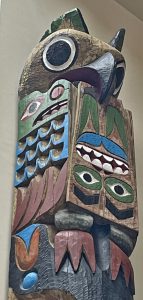
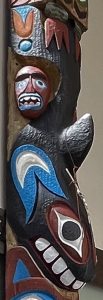
FHL Land and Waters Acknowledgement Statement
We acknowledge that we work and live on the traditional homelands of the Coast Salish peoples. The University of Washington’s Friday Harbor Laboratories acknowledge the Coast Salish peoples of this land where we teach, research, and learn – the land which touches the shared waters of all tribes within the Lhaq’temish (Lummi), Lekwungen (Songhees), Swinomish, Semiahmoo, Samish, T’sou-ke, WSÁNEĆ, and Jamestown S’Klallam, and we pledge support for Coast Salish peoples of our community and seek meaningful connections to protect our shared environment.
Tide Bites is a monthly email with the latest news and stories about Friday Harbor Labs. Want more? Subscribe to Tide Bites or browse the archives.